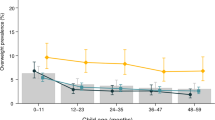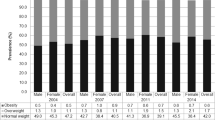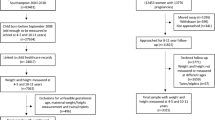Abstract
Objective: The prevalence of overweight and obesity was estimated among the school children and adolescents of three provinces of central Italy, and the role of several possible influencing factors was analysed.
Design, subjects and measurements: Body mass index (BMI) was measured in 44 231 subjects, age 3–17.5 y, and a household questionnaire was filled out by the parents of 12 143 subjects to collect the following data: subjects, only child or firstborn status, prematurity, birth weight, type of feeding until the fifth month, menarche status in girls; parents, age at the time of the subject's birth; BMI (mean of the two parents) at the time the subject was measured, mother's age of menarche, socioeconomic status. BMI was measured in a subgroup of 10 795 subjects 1 y later to study the yearly sex- and age-related variations from the categories of normal weight to overweight or obesity and vice versa. All females aged 11–14 y were asked if they had their menarche.
Results: Striking differences in the proportions of overweight and obesity resulted from the use of two different criteria for defining cutoff points. The overall prevalence of overweight was 13.2 and 20.7% in males, and 13.7 and 18.6% in females, and the overall prevalence of obesity varied between 24.2 and 6.3% in males, and between 22.9 and 6.1% in females, respectively. Parents' BMI, birth weight, firstborn status and post-menarche status in girls showed a significant association with overweight and/or obesity in logistic regression models.
Conclusions: A large prevalence of overweight and obesity was observed in school subjects from three provinces of central Italy. From the comparisons of the prevalence rate, the new internationally agreed criteria seem more appropriate for epidemiological studies in this population.
Sponsor: University of Perugia, Region of Umbria, Commune of Perugia.
This is a preview of subscription content, access via your institution
Access options
Subscribe to this journal
Receive 12 print issues and online access
$259.00 per year
only $21.58 per issue
Buy this article
- Purchase on Springer Link
- Instant access to full article PDF
Prices may be subject to local taxes which are calculated during checkout

Similar content being viewed by others
References
Bini V, Celi F, Berioli MG, Bacosi ML, Stella P, Giglio P, Tosti L & Falorni A (2000): Body mass index in children and adolescents according to age and pubertal stage. Eur. J. Clin. Nutr. 54, 214–218.
Booth ML, Wake M, Armstrong T, Chey T, Heskett K & Mathur S (2001): The epidemiology of overweight and obesity among Australian children and adolescents, 1995–97. Aust. NZJ Public Health 25, 162–169.
Chinn S & Rona RJ (2001): Prevalence and trend in overweight and obesity in three cross sectional studies of British children, 1974–94. BMJ 322, 24–30.
Cole TJ, Bellizzi MC, Flegal M & Dietz W (2000): Establishing a standard definition for child overweight and obesity worldwide: international survey. BMJ 320, 1–6.
Daniels SR, Khoury PR & Morrison JA (1997): The utility of body mass index as a measure of body fatness in children and adolescents: differences by race and gender. Pediatrics 99, 804–807.
de Onis M & Habicht JP (1996): Anthropometric reference data for international use: recommendations from a World Health Organization Expert Committee. Am. J. Clin. Nutr. 64, 650–658.
Duran-Tauleria E, Rona RJ & Chinn S (1995): Factors associated with weight for eight and skinfold thickness in British children. J. Epidemiol. Community Health 29, 466–473.
Falorni A, Bini V, Papi F, Sanasi M, Celi F, Di Stefano Gianni, Berioli MG, Contessa Gioacchina, Bacosi ML, De Giorgi G, Mazza AM, Faraoni F, Grossi S, Pascalizi A, Molinari D, Lupidi M, Cabiati G, Lotti A, Del Ponte G, Maroccia F, Stella P, Messini B, Giglio P, Gambelunghe M, Pierri F & Cari F (1998a): Accrescimento e pubertà nei soggetti in età scolare di tre province dell'Italia centrale. Crescere Insieme 3, 1–77.
Falorni A, Galmacci G, Bini V, Papi F, Molinari D, De Giorgi G, Faraoni F, Celi F, Di Stefano G, Berioli MG, Contessa C & Bacosi ML (1998b): Fasting serum leptin levels in the analysis of body mass index cut-off values: may they be useful for overweight screening in children and adolescents? A school population-based survey in three provinces of central Italy. Int. J. Obesity 22, 1197–1208.
International Obesity Task Force (IOTF) (1998): Obesity: preventing and managing the global epidemic. Report of WHO consultation on obesity, 3–5 June 1998. Geneva: WHO.
Kromeyer-Hauschild K, Zellner K, Jaeger U & Hoyer H (1999): Prevalence of overweight and obesity among school children in Jena (Germany). Int. J. Obesity 23, 1143–1150.
Livingstone B (2000): Epidemiology of childhood obesity in Europe. Eur. J. Pediatr. 159(Suppl 1), S14–S34.
Maffeis C, Micciolo R, Must A, Zaffanello M & Pinelli L (1994): Parental and perinatal factors associated with childhood obesity in north-east Italy. Int. J. Obesity 18, 301–305.
Mickey RM & Greenland S (1989): The impact of confounder selection criteria on effect estimation. Am. J. Epidemiol. 129, 125–137.
Must A, Jacques PF, Dallal GE, Bajema CJ & Dietz WH (1992): Long-term morbidity and mortality of overweight adolescents. N. Engl. J. Med. 327, 1350–1355.
Nieto FJ, Szklo M & Comstock GW (1992): Childhood weight and growth rate as predictors of adult mortality. Am. J. Epidemiol. 136, 201–213.
O'Dea J & Abraham S (1995): Should body-mass index be used in young adolescents?. Lancet 345: 657.
Poskitt EM & the European Childhood Obesity Group (1996): Committee report. Defining childhood obesity: the relative body mass index (BMI). Acta Paediatr. 84, 961–963.
Poskitt EM & Cole TJ (1978): Nature, nurture, and childhood overweight. BMJ i, 603–605.
Ravelli GP & Belmont L (1979): Obesity in nineteen-year-old men: family size and birth order association. Am. J. Epidemiol. 109, 66–70.
Reilly JJ & Dorosty AR (1999): Epidemic of obesity in UK children. Lancet 354, 1874–1875.
Rolland-Cachera MF, Cole TJ, Sempé M, Tichet J Rossignol C & Charraud A (1991). Body mass index variations: centiles from birth to 87 years. Eur. J. Clin. Nutr. 45, 13–21.
Rolland-Cachera MF, Deheeger M, Bellisle F, Sempé M, Guilloud-Bataille M & Patois E (1984): Adiposity rebound in children: a simple indicator for predicting obesity. Am. J. Clin. Nutr. 39, 129–135.
Seidell JC (1999): Obesity: a growing problem. Acta Paediatr. 428(Suppl), 46–50.
Stettler N, Tershakovec AM, Zemel BS, Leonard MB, Boston R, Katz SH & Stalling VA (2000): Early risk factors for increased adiposity: a cohort study of African American subjects followed from birth to young adulthood. Am. J. Clin. Nutr. 72, 378–383.
Wilkinson PW, Parkin JM, Pearlson J, Philips PR & Sykes P (1977): Obesity in childhood: a community study in Newcastle upon Tyne. Lancet 350–352.
Whitelaw AGL (1971): The association of social class and sibling number with skinfold thickness London schoolboys. Hum. Biol. 43, 414–420.
Author information
Authors and Affiliations
Contributions
Guarantor: A Falorni.
Contributors: FC was mainly responsible for the original idea and participated in designing the study and writing the paper. VB provided the final data collection, executed the mathematical and statistical analysis, and participated in designing the study and writing the paper. GDeG, DM, FF, GDiS, MLB, MGB and GC organised and coordinated the research project on the growth of school children in the three provinces of Perugia, Terni and Rieti, participated in collecting data on growth from the school population survey, and executed and provided protocol adherence; all of them contributed to interpreting the data and writing the paper. AF participated in developing the original idea, designing the study, analysing the data and writing the paper. He also directed protocol execution and adherence.
Corresponding author
Rights and permissions
About this article
Cite this article
Celi, F., Bini, V., Giorgi, G. et al. Epidemiology of overweight and obesity among school children and adolescents in three provinces of central Italy, 1993–2001: study of potential influencing variables. Eur J Clin Nutr 57, 1045–1051 (2003). https://doi.org/10.1038/sj.ejcn.1601640
Received:
Published:
Issue Date:
DOI: https://doi.org/10.1038/sj.ejcn.1601640
Keywords
This article is cited by
-
Unhealthy weight among children in Spain and the role of the home environment
BMC Research Notes (2018)
-
Fetuin-A, adiposity-linked insulin resistance and responsiveness to an educational-based weight excess reduction program: a population-based survey in prepubertal schoolchildren
Endocrine (2017)
-
Socioeconomic position and childhood-adolescent weight status in rich countries: a systematic review, 1990–2013
BMC Pediatrics (2015)
-
Healthy fats for healthy nutrition. An educational approach in the workplace to regulate food choices and improve prevention of non-communicable diseases
High Blood Pressure & Cardiovascular Prevention (2015)
-
Nutritional and behavioral determinants of adolescent obesity: a case–control study in Sri Lanka
BMC Public Health (2014)



